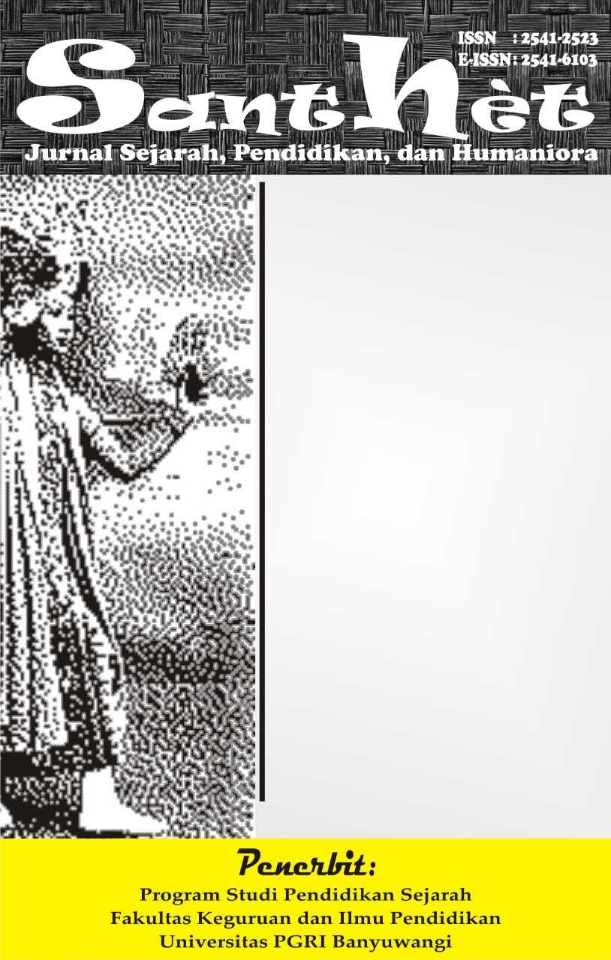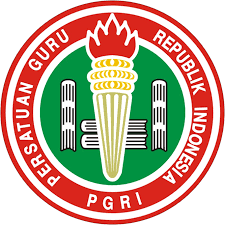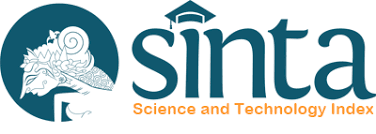LINGUAL FORM OF GARDEN NAMES AT RANOYAPO
Bentuk Lingual Nama-Nama Kebun di Ranoyapo
DOI:
https://doi.org/10.36526/santhet.v8i1.3094Keywords:
Lingual form of garden names, Morphological Process of Garden Names, Ranoyapo Garden NamesAbstract
This research aims to find out the lingual forms and cultural meanings that appear in place naming and is studied based on the formation process, use, characteristics, and also the history of the Tontemboan language form, the local language spoken in Ranoyapo sub-district which is used as the research location. Place naming refers to the study of anthropological linguistics, which studies language and history. This research is qualitative and uses a descriptive approach. In the field of linguistics, this method is used by researchers to find out about many things related to society through language and its terminology. In collecting the data, the researcher used the method of simak and cakap from Mahsun (2007), with the aim of collecting data in the form of lingual forms and the phenomenon of naming places that appear in an utterance. Meanwhile, the commensurate and distributional methods were used to analyse the lingual form data to its smallest level. Based on the results of the research, root words dominate place naming besides being caused by affixation, reduplication, and composition. For example: Danda' [dandaɂ] 'name of the creek', Sukuyon [sukuyon] 'name of the creek', Kayong [kayoŋ] 'name of the creek', Sasano [sasano] 'name of the creek', Gawayas [gawayas] 'guava tree', Pahlawan [hero] 'hero', pa'boseng [paɂboseŋ] 'name of the creek', Ma'tenem [maɂtenəm] 'drying'. Land names with the lingual forms above are location identities in which there are aspects of domination such as water, plants, people, land, objects, stones, and animals.
References
Alwasilah, Chaedar. 2002. Pokoknya Kualitatif: Dasar-dasar Merancang dan Melakukan Penelitian Kualitatif. Jakarta: PT Kiblat Utama.
Bloomfield, L.1995. Bahasa. Penerjemah: Sutikno I. Jakarta. PT. Gramedia Pustaka Utama.
Bolinger, Dwight, L. 1975. Aspect of Language. New York: Harcourt, Brace &Word Inc.
Crystal, David. 1985. A Dictionary of Linguistics and Phonetics (ed.). Oxford Basil, Blackwell, London: Andre Deutch
Chaer, Abdul. 2003. Linguistik Umum. Jakarta: Rineka Cipta.
Djajasudarma, F. 1993. Metode Linguistik.Bandung: Rafika Aditama.
Duranti, Alessandro. 1997. Linguistic Anthropology. Cambridge: Cambridge University Press.
Foley, William A. 1997. Anthropological Linguistics: An Introduction. Oxford: Blackwell
Published
Halliday, M.A.K. 1978. Language and Social Semiotics: The Social Interpretation of Language and Meaning. London: Edward Arnold.
Keraf, Goris. 1984. Tata Bahasa Indonesia. Ende Flores: Nusa Indah.
Kridalaksana, Harimurti. 1983. Pembentukan Kata Dalam Bahasa Indonesia. Jakarta:
PT Gramedia Pustaka Utama.
____________________2008. Kamus Linguistik. Jakarta: Gramedia Pustaka Utama.
Mahsun, M. S. 2005. Metode Penelitian Bahasa. Tahapan Strategi, Metode, dan Tekniknya. Jakarta:
PT Raja Grahindo Persada.
Masinambouw, E. K. M. 1997. Koenjaraningrat dan Antropologi di Indonesia. Jakarta: Penerbit A. A. I. dan Yayasan Obor Indonesia.
Miles, M dan Huberman, M. 1992. Analisis Data Kualitatif. Penerjemah Tjetjep Rohidi. Jakarta: UI Press.
Nida, E. A. 1970. Morphology, The Deskriptive Analysis of Word. Michigan: The University of
Michigan.
Renwarin, Paul Richard. 2012. Etnolinguistik Minahasa. Yogyakarta: Penerbit Kanisius
Riana, I Ketut. 2003. “Linguistik Budaya: Kedudukan dan Ranah Pengkajiannya”, dalam Pidato Pengukuhan Guru Besar Tetap pada Fakultas Sastra, Universitas Udayana. Denpasar: Universitas Udayana.
Samsuri. 1994. Analisis Bahasa. Jakarta: Erlangga.
Singkoh, Olga, 2012. Nama dan Tanah Dalam BudayaMinahasa(Disertasi). Manado,
Universitas Sam Ratulangi.
Sapir, Edward. 1985. Selected Writings in Language, Culture and Personality. Berkeley:
University of California Press.
Spradley, James P. 1997. Metode Etnografi. Jogyakarta: PT. Tiara Wacana Yogya.
Wardhaugh, (1972). Reading: A Psicholinguistics Perspective. New York: Harcourt, Brace, and World.
Yule, George. (1996). Pragmatik. Terjemahan Indah Fajar Wahyuni dan Rombe Mustajab. 2006. Yogyakarta: Pustaka Pelajar
Warouw, M. 1985. Kamus Melayu Manado–Indonesia. Jakarta: Departemen Pendidikan Indonesia.
Watupongo, Geraldine, I.J. 1983. Bahasa Melayu Surat Kabardi Minahasa pada Abadke-19. Universitas Indonesia. Jakarta. (Disertasi).





























